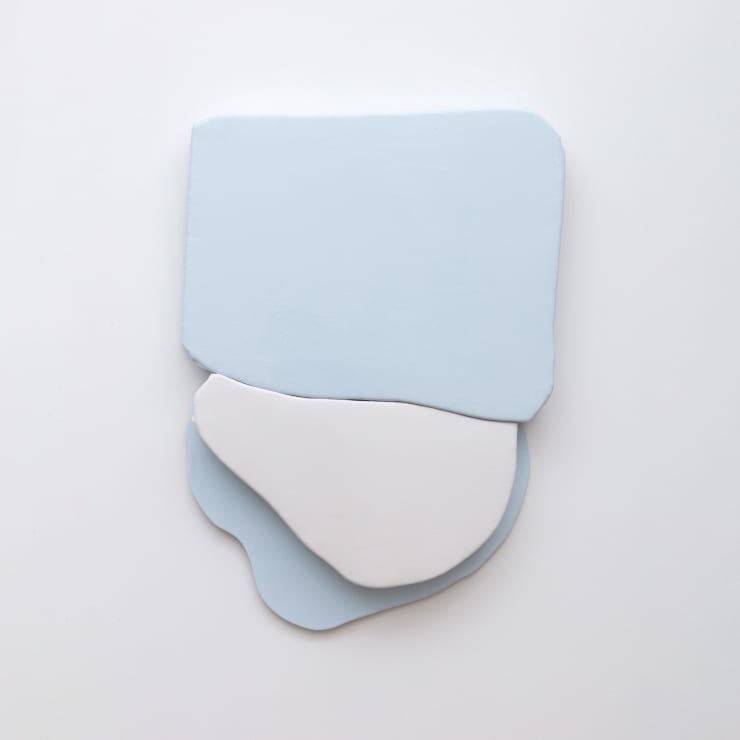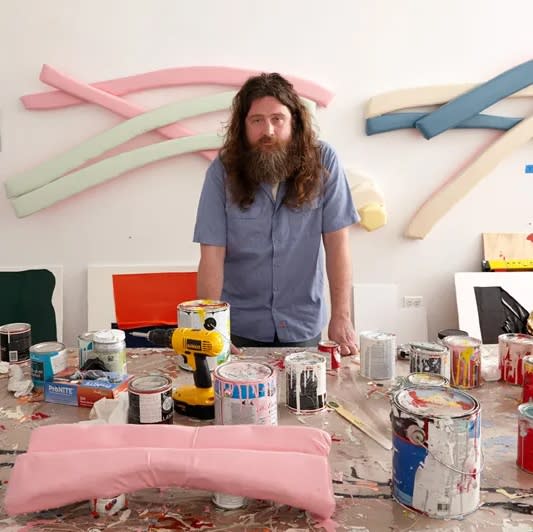Justin Adian: Casual Encounters
Stare. It is the way to educate your eye, and more. Stare, pry, listen, eavesdrop. Die knowing something. You are not here long. — Walker Evans
Hybrids of painting and sculpture, Justin Adian’s sexy and adventurous wall-mounted works recall the poured polyurethane pieces of Lynda Benglis, the abstract foam sculptures of John Chamberlain, and the shaped paintings of Ellsworth Kelly. Each of Adian’s voluptuous works is composed of organic, “puffy” forms that are glossy and reflective, in colors ranging from pastel pinks and blues to deep blacks and reds. They meet, stack, intersect, cling, overlap, or cozy up. Their touch is awkward, yet sensual and fun-loving, like lovers fumbling around in bed, legs in the wrong place, kisses missed.
Each of Adian’s works has its own energy and personality. Some seem like landscapes, especially those composed with “horizons” or “skylines” and titles such as Mesa or Rubble. But these are not abstract representations of places. Instead, they are more like casual glimpses from a car on a long, hot West Texas highway—a powdery cloud moving across an expansive blue sky; a worn, faded sign of a 1950s long-boarded-up motel; the door of a 1966 Timberline Green Mustang leaning in a junkyard. Installed in unexpected, unorthodox ways, Adian’s works push, flirt with, and alter the space that can barely contain them. They produce a wonderfully palpable atmosphere of desire, vulnerability, and fun.
Adian’s practice is process-driven. In his Brooklyn studio, he starts with a drawing. From that, he makes one large shape by stretching canvas over ester foam atop shaped planks of wood. Then, he covers the canvas with many layers of paint traditionally used for boat or automobile exteriors. Once he makes the one large component, smaller pieces—what is left—are created. Art begets art, bringing in an element of chance. For Adian, his works are open-ended “narratives” that come to him during the process of making the work. They are not linear stories, but “moments, a series of events, or a relationship to something (another artist or person),” which, in turn, motivate the artist’s choices of colors and titles.
The art and culture of Southern California filters into Adian’s aesthetic sensibility: cars and surfboards, punk rock (Black Flag was a favorite band in his youth), and the 1960s and 1970s art scene—Cool School, Light and Space, and Finish Fetish. While not as “finished,” the artist’s hybrids and manipulation of architectural space have affinities with John McCracken’s flawless, highly reflective and glossy “planks,” as well as Craig Kauffman’s industrial vacuum-formed wall-mounted reliefs that resemble giant lozenges or jelly candies.
Adian’s artistic sensibility also has roots deep in Texas. Born in Fort Worth, he attended the scrappy University of North Texas in Denton, where Vernon Fisher taught for years. (He later completed his MFA at Rutgers.) Adian’s work seems to speak of the freedom, the openness of road trips on endless highways through banal landscapes, listening to road songs by great musicians such as Willie Nelson, Gram Parson, Townes Van Zandt, and Hank Williams. As a fellow Texan, I can attest that road trips are a Texan’s zen—a total connectedness of body and mind.
But a wholly unexpected phenomenon in Adian’s work deserves further exploration: his relationship to photography. Although he does not use a camera in the making of his abstract work, as Ellsworth Kelly did at times, Adian’s democratic, nonhierarchical use of color and his ability to distill the essence of an experience into only a few details finds parallels in photographs. A similar capturing of the essence of a place and time can be found in William Eggleston (a farmer’s muddy Ford truck, a red ceiling, the contents of the photographer’s own refrigerator); Stephen Shore’s Uncommon Places (a pancake breakfast at a restaurant in Kanab, Utah; a rainbow arching over a rainy motel parking lot in Lovell, Wyoming; streets in Cincinnati and Spokane); and Walker Evans’s 1950s Freight Cars and 1970s Polaroids (vernacular architecture, abandoned houses, advertising signs and posters).
Adian is more romantic, less dispassionate and unsentimental than this group of photographers, but all of them share a love of looking. Walker Evans once said that “the matter of art in photography may come down to this: it is the capture and projection of the delights of seeing: it is the defining of observation full and felt.” With Adian’s work, there is whole lotta looking and feeling. And, thankfully, a whole lotta joy. – Suzanne Weaver













